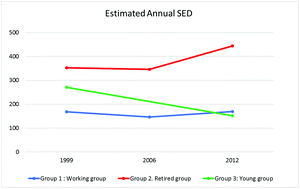当前位置:
X-MOL 学术
›
Photochem. Photobiol. Sci.
›
论文详情
Our official English website, www.x-mol.net, welcomes your
feedback! (Note: you will need to create a separate account there.)
Adult UVR exposure changes with life stage – a 14-year follow-up study using personal electronic UVR dosimeters†
Photochemical & Photobiological Sciences ( IF 2.7 ) Pub Date : 2018-11-15 00:00:00 , DOI: 10.1039/c8pp00365c
Elisabeth Thieden 1, 2, 3, 4, 5 , Ann-Sofie Sonne Holm-Schou 1, 2, 3, 4, 5 , Peter A. Philipsen 1, 2, 3, 4, 5 , Jakob Heydenreich 1, 2, 3, 4, 5 , Hans Christian Wulf 1, 2, 3, 4, 5
Photochemical & Photobiological Sciences ( IF 2.7 ) Pub Date : 2018-11-15 00:00:00 , DOI: 10.1039/c8pp00365c
Elisabeth Thieden 1, 2, 3, 4, 5 , Ann-Sofie Sonne Holm-Schou 1, 2, 3, 4, 5 , Peter A. Philipsen 1, 2, 3, 4, 5 , Jakob Heydenreich 1, 2, 3, 4, 5 , Hans Christian Wulf 1, 2, 3, 4, 5
Affiliation

|
Over a period spanning 14 years (1999–2001, 2006 and 2012), 31 volunteers participated in sun behaviour studies with the same protocol wearing a personal, electronic wrist-borne UVR dosimeter and completed sun exposure diaries resulting in a total of 15 946 measurements days (126 days per person per year). The participants individually maintained their UVR dose level and behaviour over the years. No statistically significant differences were seen from year to year in the “estimated annual UVR dose”, the “mean UVR dose per day”, the “mean percentage of ambient UVR”, “days sunbathing to get a tan”, “days with intermittent exposure” or in “sunburn episodes”. The 20 participants still active in the labour market used sunscreen on more days in 2012 than in 1999 (p = 0.019) and with a significantly higher SPF (sun protecting factor (p < 0.001)) resulting in significantly fewer days with risk behaviour without sunscreen applied in 2012 than in 2006 (p < 0.001) and 1999 (p < 0.003). This was in contrast to the 11 participants who retired during the study period. The retired group received a non-significant 45% higher UV dose in 2012 than in 1999 (p = 0.054). In an additional study, nine 30-year-old indoor workers (high school students in the 1999 study) had changed their sun exposure pattern and had fewer days sunbathing (p = 0.008) and fewer risk behaviour days without sunscreen applied in 2012 than in 1999 (p = 0.002). Conclusion: The participants still active in the labour market maintained their sun exposure behaviour over a 14-year period. The retirees had a higher UVR dose and riskier exposure behaviour after retirement, while the high school students had changed to less risky sun behaviour on becoming indoor workers.
中文翻译:

成人UVR暴露会随着生命阶段的变化而变化–使用个人电子UVR剂量计进行的为期14年的随访研究†
在14年(1999-2001、2006和2012年)中,有31名志愿者穿着相同的方案参加了太阳行为研究,佩戴的是个人的手腕电子UVR剂量计,并完成了日晒日记,总共进行了15946次测量天(每人每年126天)。参与者多年来一直保持自己的UVR剂量水平和行为。在“估计的年度UVR剂量”,“每天的平均UVR剂量”,“环境UVR的平均百分比”,“晒日光浴晒黑的天数”,“间歇性的天数”之间,每年之间均没有统计学上的显着差异。曝光”或“晒伤发作”中。2012年仍活跃于劳动力市场的20名参与者使用防晒霜的时间比1999年更长(p= 0.019)和更高的SPF(防晒系数(p <0.001))导致2012年不使用防晒霜的有风险行为的天数明显少于2006(p <0.001)和1999(p <0.003)。这与研究期间退休的11名参与者相反。退休组在2012年的紫外线剂量比1999年高出45%(p = 0.054)。在另一项研究中,2012年有9名30岁的室内工人(1999年研究中的高中生)改变了他们的日光照射方式,日光浴的天数更少(p = 0.008),并且没有防晒霜的风险行为天数比2012年少。 1999(p = 0.002)。结论:仍活跃在劳动力市场中的参与者在14年的时间内保持了他们的日晒行为。退休人员退休后具有较高的UVR剂量和较高的暴露行为,而高中生在成为室内工人时已经改变为低风险的日晒行为。
更新日期:2018-11-15
中文翻译:

成人UVR暴露会随着生命阶段的变化而变化–使用个人电子UVR剂量计进行的为期14年的随访研究†
在14年(1999-2001、2006和2012年)中,有31名志愿者穿着相同的方案参加了太阳行为研究,佩戴的是个人的手腕电子UVR剂量计,并完成了日晒日记,总共进行了15946次测量天(每人每年126天)。参与者多年来一直保持自己的UVR剂量水平和行为。在“估计的年度UVR剂量”,“每天的平均UVR剂量”,“环境UVR的平均百分比”,“晒日光浴晒黑的天数”,“间歇性的天数”之间,每年之间均没有统计学上的显着差异。曝光”或“晒伤发作”中。2012年仍活跃于劳动力市场的20名参与者使用防晒霜的时间比1999年更长(p= 0.019)和更高的SPF(防晒系数(p <0.001))导致2012年不使用防晒霜的有风险行为的天数明显少于2006(p <0.001)和1999(p <0.003)。这与研究期间退休的11名参与者相反。退休组在2012年的紫外线剂量比1999年高出45%(p = 0.054)。在另一项研究中,2012年有9名30岁的室内工人(1999年研究中的高中生)改变了他们的日光照射方式,日光浴的天数更少(p = 0.008),并且没有防晒霜的风险行为天数比2012年少。 1999(p = 0.002)。结论:仍活跃在劳动力市场中的参与者在14年的时间内保持了他们的日晒行为。退休人员退休后具有较高的UVR剂量和较高的暴露行为,而高中生在成为室内工人时已经改变为低风险的日晒行为。

































 京公网安备 11010802027423号
京公网安备 11010802027423号